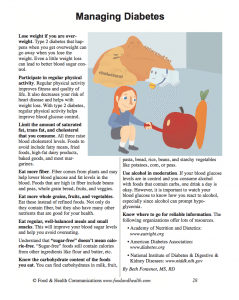A Closer Look at the ADA's General Targets for Diabetics
 The American Diabetes Association (ADA) has just released the Targets for Most People with Diabetes. By now you've read the post by Jill Weisenberger, MS, RDN, CDE, FAND, and gotten your free copy of the progress tracking chart. But what exactly is the ADA? And what's changed about the latest edition of the guidelines?To get answers, you've come to the right place.Let's start with the ADA. Their stated mission is "To prevent and cure diabetes and to improve the lives of all people affected by diabetes." To that end, they have put together an enormously helpful website that features tools to help people evaluate their risk of diabetes, view fact sheets about diabetes basics, and discuss healthful living with diabetes, especially when it comes to food and fitness. There are even resources for community events and patient advocacy!The ADA provides objective information about diabetes while funding all kinds of diabetes research. According to their About Us page, "We lead the fight against the deadly consequences of diabetes and fight for those affected by diabetes."In order to support these goals, and backed by lots of empirical research, the ADA periodically releases guides to preventing and living with diabetes. The Targets for Most People with Diabetes is just one of those guides.
The American Diabetes Association (ADA) has just released the Targets for Most People with Diabetes. By now you've read the post by Jill Weisenberger, MS, RDN, CDE, FAND, and gotten your free copy of the progress tracking chart. But what exactly is the ADA? And what's changed about the latest edition of the guidelines?To get answers, you've come to the right place.Let's start with the ADA. Their stated mission is "To prevent and cure diabetes and to improve the lives of all people affected by diabetes." To that end, they have put together an enormously helpful website that features tools to help people evaluate their risk of diabetes, view fact sheets about diabetes basics, and discuss healthful living with diabetes, especially when it comes to food and fitness. There are even resources for community events and patient advocacy!The ADA provides objective information about diabetes while funding all kinds of diabetes research. According to their About Us page, "We lead the fight against the deadly consequences of diabetes and fight for those affected by diabetes."In order to support these goals, and backed by lots of empirical research, the ADA periodically releases guides to preventing and living with diabetes. The Targets for Most People with Diabetes is just one of those guides. Now let's take a look at that guide in particular. What's new for 2015?Jill Weisenberger will lay it out for us.First, the pre-meal blood glucose target is now 80-130 mg/dl. It has been changed in order to better reflect new information that compares actual blood glucose levels to A1C targets. The previous goal was 70-130 mg/dl.Second, the blood pressure target is currently 140/90 mmHg for people with both diabetes and hypertension. It was previously 140/80 mmHg. A meta-analysis of randomized clinical trials of adults with type 2 diabetes found no significant reduction in nonfatal heart attack or death when blood pressure targets were more strict. The risk of stroke was reduced with tighter blood pressure goals, but the risk of side effects was high.Finally, the ADA has done away with specific low-density lipoprotein (LDL) cholesterol goals. Instead treatment with a statin drug is based on cardiovascular risk rather than LDL levels. However, one of the risk factors for cardiovascular disease is LDL level > 100 mg/dl.And there you have it! The changes to the guidelines and their rationale!Now it's time to talk about handouts. Here's an excerpt from the 12 Lessons of Diabetes, a fantastic and comprehensive diabetes education program. This handout was written by Beth Fontenot, MS, RD, and features 10 great tips for managing diabetes. Get your copy today!
Now let's take a look at that guide in particular. What's new for 2015?Jill Weisenberger will lay it out for us.First, the pre-meal blood glucose target is now 80-130 mg/dl. It has been changed in order to better reflect new information that compares actual blood glucose levels to A1C targets. The previous goal was 70-130 mg/dl.Second, the blood pressure target is currently 140/90 mmHg for people with both diabetes and hypertension. It was previously 140/80 mmHg. A meta-analysis of randomized clinical trials of adults with type 2 diabetes found no significant reduction in nonfatal heart attack or death when blood pressure targets were more strict. The risk of stroke was reduced with tighter blood pressure goals, but the risk of side effects was high.Finally, the ADA has done away with specific low-density lipoprotein (LDL) cholesterol goals. Instead treatment with a statin drug is based on cardiovascular risk rather than LDL levels. However, one of the risk factors for cardiovascular disease is LDL level > 100 mg/dl.And there you have it! The changes to the guidelines and their rationale!Now it's time to talk about handouts. Here's an excerpt from the 12 Lessons of Diabetes, a fantastic and comprehensive diabetes education program. This handout was written by Beth Fontenot, MS, RD, and features 10 great tips for managing diabetes. Get your copy today! And there are lots more diabetes resources in the Nutrition Education Store. I think you'd especially like these options...
And there are lots more diabetes resources in the Nutrition Education Store. I think you'd especially like these options...


